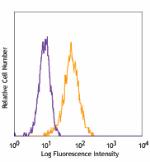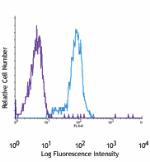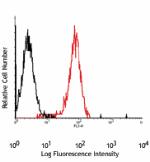- Clone
- APB5 (See other available formats)
- Regulatory Status
- RUO
- Other Names
- PDGF receptor-β, PDGFR-β, platelet-derived growth factor receptor beta
- Isotype
- Rat IgG2a, κ
- Ave. Rating
- Submit a Review
- Product Citations
- publications
| Cat # | Size | Price | Quantity Check Availability | Save | ||
|---|---|---|---|---|---|---|
| 136011 | 100 µg | 176€ | ||||
| 136012 | 1 mg | 542€ | ||||
Platelet-derived growth factor receptor-β (PDGFR-β), CD140b, is one of two receptors for platelet-derived growth factors (PDGFs) and binds to all isoforms of PDGFs. PDGFRβ is a receptor tyrosine kinase that forms homodimers or heterodimers on the surface upon ligand binding and phosphorylates substrates. PDGFRs consist of either homodimers of α/α, β/β, or heterodimers of α/β. PDGF receptors, α and β, are single glycoproteins with intracellular tyrosine kinase domain. Their ligand, PDGF, is a mitogen for connective tissue and glial cells. CD140b is expressed on embryonic tissues and mesenchymal-derived cells adult mice. PDGF plays a role in wound healing and acts as a chemoattractant for fibroblasts, smooth muscle cells, glial cells, monocytes, and neutrophils.
Product DetailsProduct Details
- Verified Reactivity
- Mouse
- Antibody Type
- Monoclonal
- Host Species
- Rat
- Immunogen
- Mouse PDGFR-β-hIgG1 recombinant fusion protein
- Formulation
- 0.2 µm filtered in phosphate-buffered solution, pH 7.2, containing no preservative.
- Endotoxin Level
- Less than 0.01 EU/µg of the protein (< 0.001 ng/µg of the protein) as determined by the LAL test.
- Preparation
- The Ultra-LEAF™ (Low Endotoxin, Azide-Free) antibody was purified by affinity chromatography.
- Concentration
- The antibody is bottled at the concentration indicated on the vial, typically between 2 mg/mL and 3 mg/mL. Older lots may have also been bottled at 1 mg/mL. To obtain lot-specific concentration and expiration, please enter the lot number in our Certificate of Analysis online tool.
- Storage & Handling
- The antibody solution should be stored undiluted between 2°C and 8°C. This Ultra-LEAF™ solution contains no preservative; handle under aseptic conditions.
- Application
-
FC - Quality tested
Block, WB - Reported in the literature, not verified in house - Recommended Usage
-
Each lot of this antibody is quality control tested by immunofluorescent staining with flow cytometric analysis. For flow cytometric staining, the suggested use of this reagent is ≤ 0.25 µg per million cells in 100 µL volume. It is recommended that the reagent be titrated for optimal performance for each application.
- Application Notes
-
Additional reported (for the relevant formats) applications include: Western blotting and blocking function2. The Ultra-LEAF™ purified antibody is recommended for functional assays.
- Application References
-
- Sano H, et al. 2001. Circulation 103:2955.
- Sano H, et al. 2002. Am. J. Pathol. 161:135. (Block)
- RRID
-
AB_2832491 (BioLegend Cat. No. 136011)
AB_2832492 (BioLegend Cat. No. 136012)
Antigen Details
- Structure
- Beta chain of the platelet-derived growth factor receptor, a receptor tyrosine kinase that forms homo- or hetero-dimers on the surface after ligand binding.
- Distribution
-
Expressed on embryonic tissues and mesenchymal-derived cells of adult mouse.
- Function
- Play a role in wound healing and act as a chemoattractant for fibroblasts, smooth muscle cells, glial cells, monocytes and neutrophils.
- Ligand/Receptor
- PDGFs
- Cell Type
- Embryonic Stem Cells, Mesenchymal Stem Cells
- Biology Area
- Cell Biology, Immunology, Neuroscience, Neuroscience Cell Markers, Stem Cells
- Molecular Family
- CD Molecules, Cytokine/Chemokine Receptors
- Antigen References
-
1. Soriano P, et al. 1994. Genes Dev. 8:1888
2. Takakura N, et al. 1996. J Invest Dermatol. 107:770
3. Yarden Y, et al. 1986. Nature 323:226 - Gene ID
- 18596 View all products for this Gene ID
- UniProt
- View information about CD140b on UniProt.org
Related FAQs
- Do you guarantee that your antibodies are totally pathogen free?
-
BioLegend does not test for pathogens in-house aside from the GoInVivo™ product line. However, upon request, this can be tested on a custom basis with an outside, independent laboratory.
- Does BioLegend test each Ultra-LEAF™ antibody by functional assay?
-
No, BioLegend does not test Ultra-LEAF™ antibodies by functional assays unless otherwise indicated. Due to the possible complexities and variations of uses of biofunctional antibodies in different assays and because of the large product portfolio, BioLegend does not currently perform functional assays as a routine QC for the antibodies. However, we do provide references in which the antibodies were used for functional assays and we do perform QC to verify the specificity and quality of the antibody based on our strict specification criteria.
- Does BioLegend test each Ultra-LEAF™ antibody for potential pathogens?
-
No, BioLegend does not test for pathogens in-house unless otherwise indicated. However, we can recommend an outside vendor to perform this testing as needed.
- Have you tested this Ultra-LEAF™ antibody for in vivo or in vitro applications?
-
We don't test our antibodies for in vivo or in vitro applications unless otherwise indicated. Depending on the product, the TDS may describe literature supporting usage of a particular product for bioassay. It may be best to further consult the literature to find clone specific information.
Other Formats
View All CD140b Reagents Request Custom Conjugation| Description | Clone | Applications |
|---|---|---|
| Purified anti-mouse CD140b | APB5 | FC,WB,Block |
| PE anti-mouse CD140b | APB5 | FC |
| APC anti-mouse CD140b | APB5 | FC |
| Biotin anti-mouse CD140b | APB5 | FC |
| Ultra-LEAF™ Purified anti-mouse CD140b | APB5 | FC,Block,WB |
Compare Data Across All Formats
This data display is provided for general comparisons between formats.
Your actual data may vary due to variations in samples, target cells, instruments and their settings, staining conditions, and other factors.
If you need assistance with selecting the best format contact our expert technical support team.
-
Purified anti-mouse CD140b

Mouse fibroblast NIH/3T3 cells stained with APB5 PE 
C57BL/6 splencoytes stained with APB5 PE -
PE anti-mouse CD140b

Mouse fibroblast NIH/3T3 cells stained with APB5 PE 
C57BL/6 splencoytes stained with APB5 PE -
APC anti-mouse CD140b

Mouse fibroblast NIH/3T3 cells stained with APB5 APC -
Biotin anti-mouse CD140b

Mouse fibroblast NIH/3T3 cells stained with biotinylated APB... -
Ultra-LEAF™ Purified anti-mouse CD140b
 Login / Register
Login / Register 









Follow Us